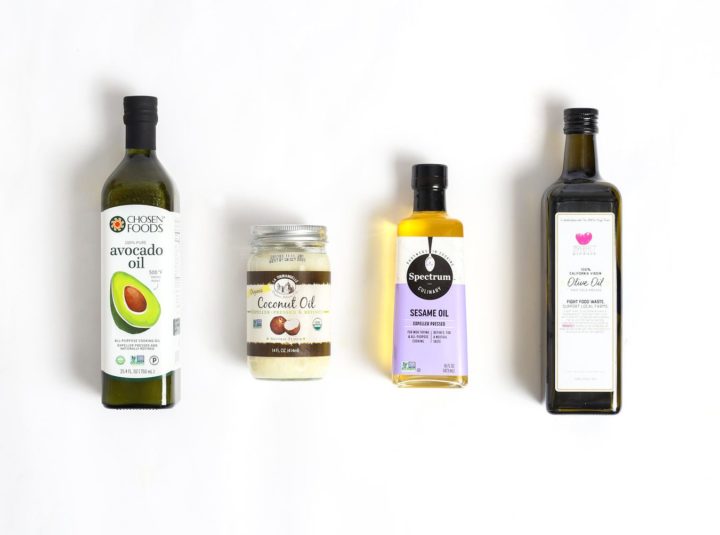As if cooking wasn’t complicated enough, enter neutral oils. I mean WTF is a neutral oil! Don’t stress, we’re here to break it all down for you! And in reality, it’s pretty simple.
A neutral oil is simply a flavorless cooking oil. Different from stronger oils like olive oil or even avocado oil, oils such as vegetable, grapeseed, and canola are used in cooking, and more specifically in baking, because of their clean, simple flavor.
If this is news to you, don’t feel bad. They don’t teach this stuff in grade school and while grandma may have always known it, she’s not likely to have sat you down to talk about it. Of course, if you think back to every cake mix you’ve ever seen, you’re likely to realize that vegetable oil is the oil of choice while extra virgin olive oil never makes that list.
The cool thing about these oils is their versatility. You can fry with them, season with them, and bake with them. So read on to get the 411 on when and why to choose them.
Avocado Oil
(the healthy betch, I mean oil)
Made from avocado pulp, it can be used in just about anything. Similar in quality to coconut oil, avocado oil is versatile, serving as a butter substitute, base for a salad dressing, and even for treating hair, skin, and cuticles.
Grapeseed Oil
Fun fact: wine is the reason we have grapeseed oil because it is actually a byproduct of winemaking. Yes, we relate everything back to wine because wine slaps.
Grape seeds are removed from the rest of the grape, then pressed to make a light, slightly flavorful oil that can be used in just about anything. High in vitamin E and omega-6, it is on the list of heart-smart oils. It has a high smoke point making it ideal for deep-frying, while also being great for dressings, baking, and so much more.
Coconut Oil
Coconut oil is made from the dried meat of the coconut. It’s well suited for baking and stir-frying, and has many uses around the house. In fact, it is commonly used in ‘health-conscious’ circles because of its ancillary benefits. Great for baking, stir-frying, sauteing, and more, it does have a subtle flavor that you have to like. The added bonus is that you can use it to help dry hair, skin, and more.
Just be careful of the betch with the allergies, because she is probably allergic to coconut and she may not ask which oil you cooked with.
Vegetable Oil
Vegetable oil is really a misnomer with two types of oils falling into this classification. The first is the general with basically all oils made from nuts, fruits, and seeds. The second is the grouping labeled “Pure Vegetable Oil” which typically comes from soybeans or a blend of several vegetable oils.
Great for deep frying because of its neutral favor and high smoke point, it is also, unfortunately, one of the least healthy oils. That said, it’s neutral flavor makes it amazing as a base oil for fried chicken, stir-fries, and just about any baked good. The fact we call it “Vegetable Oil” is ridic! You’re right, God, we did deserve 2020 (Just kidding!).
Canola Oil
Speaking of misnomers, there is no such thing as a canola plant. This neutral oil is actually made from the seeds of the rapeseed plant and is great in everything including dressings, deep-frying, stir-frying, and baking. It can also be used to grease pans before sauteing or baking making it one of the more versatile oils around.
A Note About Other Oils
In addition to the list above, there are a hand full of other neutral oils that include:
- Safflower oil
- Sunflower oil
There are also a host of fun oils that are definitely not neutral. These include:
- Olive oil and extra virgin olive oil — Made from olives, the more expensive variants are great as a finishing touch because of the rich flavoring. Extra virgin and virgin olive oils are a great option in salad dressings, sauces (especially Mediterranean dishes), and more. While regular olive oil dances on the edge of being considered a neutral oil, it can actually be used as a substitute in baking as well as in pan-frying and sautéing.
- Peanut oil — Made from the seeds of the peanut plant. There are a variety of types, depending on how refined the oil is. This oil has a high smoke point and is used by some fast food places in the fryer. Frequently found in Asian cuisine, it’s flavor may range from mild to nutty. Again, watch out for the allergy peeps.
- Sesame oil — Derived from sesame seed this oil has a strong, nutty taste. Found frequently in Asian and Middle Eastern recipes, it is low in saturated fat so it’s a great option for heart health.
- Chili oil — Considered the spiciest of the oils and is a great addition to most dishes. Made from chili, it is best used with care because it will definitely spice up your dish.
Have your own tips to share? Post them in the comments section below!



